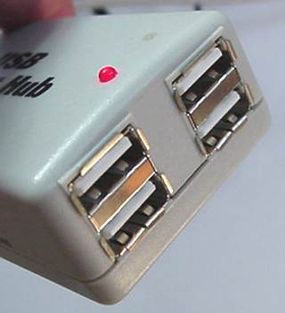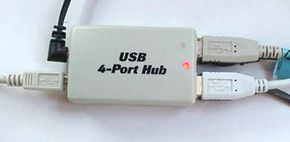Just about every peripheral made now comes in a USB version. Here's a list of some of the USB devices that you can buy today:
- Printers
- Scanners
- Mice
- Joysticks
- Flight yokes
- Digital cameras
- Webcams
- Scientific data acquisition devices
- Modems
- Speakers
- Telephones
- Video phones
- Storage devices like Zip drives
- Network connections
Most computers that you buy today come with only one or two USB sockets. With so many USB devices on the market today, you easily run out of sockets very quickly. For example, on the computer that I am typing on right now, I have a USB printer, a USB scanner, a USB Webcam and a USB network connection. My computer has only one USB connector on it, so the obvious question is, "How do you hook up all the devices?"
Advertisement
The easy solution to the problem is to buy an inexpensive USB hub. The USB standard supports up to 127 devices, and USB hubs are a part of the standard.

A hub typically has four new ports, but may have many more. You plug the hub into your computer, and then plug your devices (or other hubs) into the hub. By chaining hubs together, you can build up dozens of available USB ports on a single computer.
Hubs can be powered or unpowered. As you learn in How USB Ports Work, the USB standard allows for devices to draw their power from their USB connection (all USB cables contain two wires -- for +5 volts and ground). A high-power device like a printer or scanner will have its own power supply, but low-power devices like mice and digital cameras get their power from the bus. The power (up to 500 milliamps at 5 volts) comes from the computer. If you have lots of self-powered devices (like printers and scanners), then your hub does not need to be powered -- none of the devices connecting to the hub need additional power, so the computer can handle it. If you have lots of unpowered devices like mice and cameras, you probably need a powered hub. The hub has its own transformer, and it supplies power to the devices that connect to the hub so the devices do not overload the computer's power supply.
The Universal Serial Bus can easily handle both a scanner and a printer, even if you are scanning and printing at the same time. The original USB supports up to 12 megabits per second, and USB 2.0 supports up to 480 megabits per second -- considering that most devices consume only 6 megabits per second, you can definitely run more than one device at a time.
Advertisement
